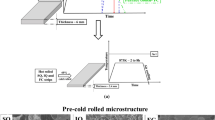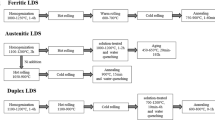Abstract
This overview provides examples of recent areas of research related to physical metallurgy of low-carbon sheet steels. Development of new alloys and microstructures, understanding mechanical behavior in new loading regimes, and understanding microstructure evolution in response to new processing methods are shown to provide continued challenges and opportunity. Ferrous physical metallurgy remains an active and fruitful field of research.
Similar content being viewed by others
References
David K. Matlock et al., “A Correlation of Processing Variables with Deformation Behavior of Dual-Phase Steels,”Structure and Properties of Dual-Phase Steels, ed. R.A. Kot and J.W. Morris (Warrendale, PA: TMS, 1979), pp. 62–90.
D.A. Korzekwa, D.K. Matlock, and G. Krauss, “Dislocation Substructure as a Function of Strain in a Dual-Phase Steel,“Metall. Trans. A, 15A (June 1984), pp. 1221–1228.
S. Traint et al., “Influence of Manganese, Silicon, and Aluminium on the Transformation Behavior of Low Alloyed TRIP-Steels,”Proc. 42nd Mechanical Working and Steel Processing Conference (Warrendale, PA: ISS, 2000), pp. 549–561.
Jody Shaw et al., “ULSAB—Advanced Vehicle Concepts—Materials,”SAE SP-1685 New Steel Sheet and Steel Bar Products and Processing, ed. D.W. Andersonet al. (Warrendale, PA: SAE, 2002), pp. 63–71.
Yoshifumi Ojima et al., “Application to Body Parts of High-Strength Steel Sheet Containing Large Volume Fraction of Retained Austenite,”SAE SP-1349 Steel Sheet and Bar Products and Processing for Automotive Applications, ed. V.C. Shah et al. (Warrendale, PA: SAE, 1998), pp. 39–48.
William C. Leslie,The Physical Metallurgy of Steels (New York: McGraw-Hill Book Company, 1981), p. 27.
K. Miura et al., “High Strain Rate Deformation of High Strength Sheet Steels for Automotive Parts,”SAE SP-1349 Steel Sheet and Bar Products and Processing for Automotive Applications, ed. V.C. Shah et al. (Warrendale, PA: SAE, 1998), pp. 23–30.
D.K. Matlock, B.J. Allen, and J.G. Speer, “Aging Behavior and Properties of Ultra-Low Carbon Bake-Hardening Steels,”Proc. Int. Symp. on Modern Low Carbon and Ultra Low Carbon Sheet Steels for Cold Forming: Processing and Properties (Aachen, Germany: Verlag Mainz, 1998), pp. 265–276.
Waleed Al Shalfan et al., “Internal Friction Measurements of Ultra-Low Carbon Sheet Steels,”Proc. 42nd Mechanical Working and Steel Processing Conference (Warrendale, PA: SAE, 2000), pp. 741–753.
Yiting Wen, Quanmin Su, and Manfred Wuttig, “Interstitial Analysis of Ultra Low Carbon and Interstitial Free Steels,”Proc. 39th Mechanical Working and Steel Processing Conference (Warrendale, PA: ISS, 1998), pp. 271–280.
Jeffrey S. Blanzy et al., “Microstructural Evolution and Mechanical Properties of Induction Heated Low Carbon Sheet Steel,”Proc. 43rd Mechanical Working and Steel Processing Conference (Warrendale, PA: ISS, 2001), pp. 805–812.
Author information
Authors and Affiliations
Rights and permissions
About this article
Cite this article
Speer, J.G., Matlock, D.K. Recent developments in low-carbon sheet steels. JOM 54, 19–24 (2002). https://doi.org/10.1007/BF02700981
Issue Date:
DOI: https://doi.org/10.1007/BF02700981




